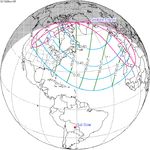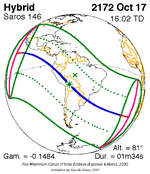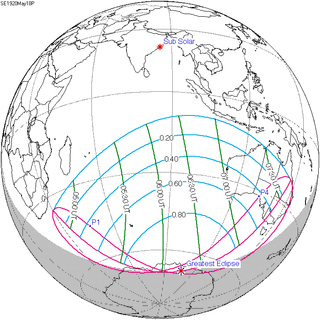Solar eclipse of May 18, 1920
| Solar eclipse of May 18, 1920 | |
|---|---|
| Type of eclipse | |
| Nature | Partial |
| Gamma | −1.0239 |
| Magnitude | 0.9734 |
| Maximum eclipse | |
| Coordinates | 69°06′S 107°42′E / 69.1°S 107.7°E |
| Times (UTC) | |
| Greatest eclipse | 6:14:55 |
| References | |
| Saros | 146 (22 of 76) |
| Catalog # (SE5000) | 9328 |
A partial solar eclipse occurred on Tuesday, May 18, 1920. A solar eclipse occurs when the Moon passes between Earth and the Sun, thereby totally or partly obscuring the image of the Sun for a viewer on Earth. A partial solar eclipse occurs in the polar regions of the Earth when the center of the Moon's shadow misses the Earth.
Related eclipses[edit]
Solar eclipses 1916–1920[edit]
This eclipse is a member of a semester series. An eclipse in a semester series of solar eclipses repeats approximately every 177 days and 4 hours (a semester) at alternating nodes of the Moon's orbit.[1]
| Solar eclipse series sets from 1916 to 1920 | ||||
|---|---|---|---|---|
| Ascending node | Descending node | |||
| 111 | December 24, 1916 Partial |
116 | June 19, 1917 Partial | |
| 121 | December 14, 1917 Annular |
126 | June 8, 1918 Total | |
| 131 | December 3, 1918 Annular |
136 | May 29, 1919 Total | |
| 141 | November 22, 1919 Annular |
146 | May 18, 1920 Partial | |
| 151 | November 10, 1920 Partial | |||
Saros 146[edit]
It is a part of Saros cycle 146, repeating every 18 years, 11 days, containing 76 events. The series started with partial solar eclipse on September 19, 1541. It contains total eclipses from May 29, 1938 through October 7, 2154, hybrid eclipses from October 17, 2172 through November 20, 2226, and annular eclipses from December 1, 2244 through August 10, 2659. The series ends at member 76 as a partial eclipse on December 29, 2893. The longest duration of totality was 5 minutes, 21 seconds on June 30, 1992.
| Series members 21-37 occur between 1901 and 2200: | ||
|---|---|---|
| 21 | 22 | 23 |
 May 7, 1902 |
 May 18, 1920 |
 May 29, 1938 |
| 24 | 25 | 26 |
 June 8, 1956 |
 June 20, 1974 |
 June 30, 1992 |
| 27 | 28 | 29 |
 July 11, 2010 |
 July 22, 2028 |
 August 2, 2046 |
| 30 | 31 | 32 |
 August 12, 2064 |
 August 24, 2082 |
 September 4, 2100 |
| 33 | 34 | 35 |
 September 15, 2118 |
 September 26, 2136 |
 October 7, 2154 |
| 36 | 37 | |
 October 17, 2172 |
 October 29, 2190 | |
Notes[edit]
- ^ van Gent, R.H. "Solar- and Lunar-Eclipse Predictions from Antiquity to the Present". A Catalogue of Eclipse Cycles. Utrecht University. Retrieved 6 October 2018.
References[edit]
- Earth visibility chart and eclipse statistics Eclipse Predictions by Fred Espenak, NASA/GSFC




